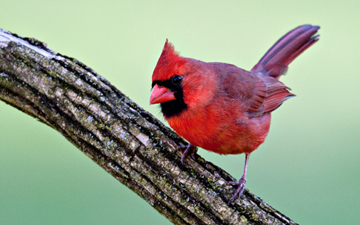The Northern Cardinal or Redbird or Common Cardinal (Cardinalis cardinalis) is a North American bird in the genus Cardinalis. It can be found in southern Canada, through the eastern United States from Maine to Texas and south through Mexico. It can also be found on the Big Island of Hawaii. It is found in woodlands, gardens, shrublands, and swamps.
The Northern Cardinal is a mid-sized songbird with a body length of 21 centimeters. It has a distinctive crest on the head and a mask on the face which is black in the male and gray in the female. The male is a vibrant red, while the female is a dull red-brown shade. The Northern Cardinal is mainly granivorous, but also feeds on insects and fruit. The male behaves territorially, marking out his territory with song. During courtship, the male feeds seed to the female beak-to-beak. A clutch of three to four eggs is laid, and two to four clutches are produced each year. It was once prized as a pet, but its sale as cage birds is now banned in the United States by the Migratory Bird Treaty Act of 1918.
(From Wikipedia, May 12, 2010)
– – –
Northern cardinals are medium-sized songbirds. Males are bright red except for a black mask on their face. Females are light brown or light greenish-brown, with reddish highlights and do not have a black mask (but parts of their face may be dark). Both males and females have thick, orange-red, cone-shaped bills, a long tail, and a distinctive crest of feathers on the top of their heads. Males are slightly larger than females. Males are 22.2 to 23.5 cm long whereas females are 20.9 to 21.6 cm long. The average weight of adult cardinals is 42 to 48 g. Immature cardinals are similar in appearance to females, but have a gray-black rather than orange-red bill.
There are 18 subspecies of Cardinalis cardinalis. The majority of these subspecies are distinguished based on the color of the face-mask in females. (Kielb, Swales, and Wolinski, 1992)
(From EOL via Animal Diversity Web)
– – –





